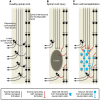Reconstructing neural circuits using transplanted neural stem cells in the injured spinal cord
- PMID: 20714103
- PMCID: PMC2929740
- DOI: 10.1172/JCI43575
Reconstructing neural circuits using transplanted neural stem cells in the injured spinal cord
Abstract
Traumatic spinal cord injury is one of the most common causes of disability in young adults. Restoring independent ambulation in such patients is considered one of the biggest challenges in regenerative medicine because repair of spinal cord injury involves the complex processes of axonal regeneration, remyelination, and formation of new synaptic connections. In this issue of the JCI, Abematsu et al. report their attempts to rise to this challenge, showing in a mouse model of severe spinal cord injury that spinal neuronal circuits can be restored by neural stem cell transplantation, leading to impressive functional recovery in the hind limbs.
Figures

Comment on
-
Neurons derived from transplanted neural stem cells restore disrupted neuronal circuitry in a mouse model of spinal cord injury.J Clin Invest. 2010 Sep;120(9):3255-66. doi: 10.1172/JCI42957. Epub 2010 Aug 16. J Clin Invest. 2010. PMID: 20714104 Free PMC article.
References
-
- Reilly P. The impact of neurotrauma on society: an international perspective. Prog Brain Res. 2007;161:3–9. - PubMed

